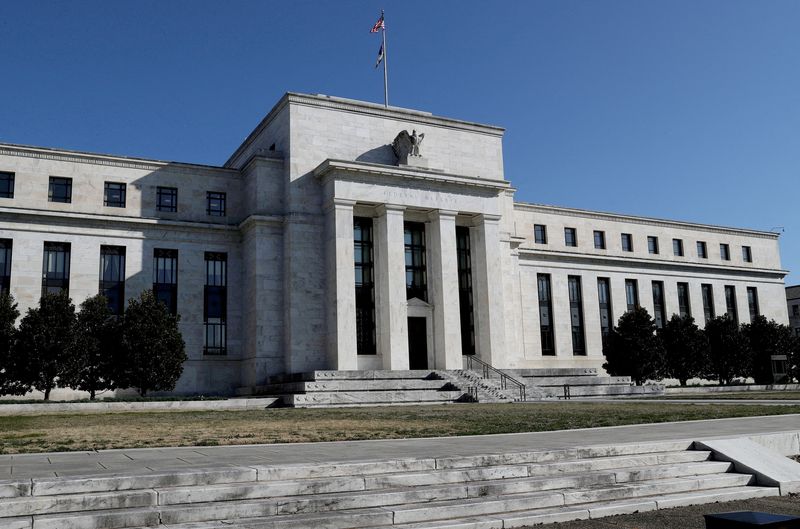U.S. bank loan plan provides Fed rate hike path amid SVB fallout
Reuters
Published Mar 14, 2023 05:15PM ET
Updated Mar 15, 2023 07:32AM ET

By Gertrude Chavez-Dreyfuss
NEW YORK (Reuters) -A U.S. lending program to stem deposit outflows in the wake of Silicon Valley Bank's collapse gives the Federal Reserve scope to continue raising interest rates if needed to slow inflation without exacerbating losses on bonds held by banks.
That said, Tuesday's U.S. inflation news should not force the Fed's hand on aggressive hikes, as was expected before the regional bank crisis unfolded in recent days.
Under the Bank Term Funding Program (BTFP), aimed at shoring up liquidity in the sector, the Fed will provide banks with one-year loans at the rate of a one-year overnight index swap (OIS) plus 10 basis points (bps). Banks can use eligible government securities on their books like Treasuries and agency mortgage backed-debt to guarantee the loans.
Crucially, the program values these at par rather than at mark-to-market which helped submerge SVB.
The current one-year OIS rate on Tuesday was last at 4.73%. By comparison, a one-year loan from a Federal Home Loan Bank, a government state enterprise that provides low-cost lending to regional banks, is around 5.4%, according to market participants.
The ability to pledge discounted bonds that have marked-to-market losses with the surge in interest rates should help banks considerably, as intended, analysts said, which should give the Fed some flexibility to continue to tighten monetary policy.
"The net impact of the regional bank funding turmoil and the new lending program still means, on balance, less accommodative financial conditions than we were expecting a week ago," said Lou Crandall, chief economist at money market research firm Wrightson in New York.
"The Fed doesn't want to stop tightening prematurely because of stability concerns. It wants to find stability tools. In essence, the bank lending program will allow the Fed to keep raising rates."
California regulators shut down SVB last Friday following a failed stock sale that took out $42 billion in deposits in a single day. SVB had to fill in a $1.8 billion funding hole after it sold a $21 billion portfolio of available-for-sale securities at a loss as rising interest rates eroded the value of U.S. Treasuries.
With the new bank lending scheme, "banks will not be forced to liquidate bond portfolios at huge losses, even if they face funding pressures," said Ryan Swift, bond strategist at BCA Research in Montreal.
"Instead, banks can meet their liquidity needs by borrowing from the Fed. For the bond market, the structure of this facility means that the Fed can keep lifting rates without exacerbating the problem of unrealized bond losses in bank portfolios."
The latest Fitch Ratings report showed unrealized losses on bank securities portfolios stood at $690 billion as of Sept. 30, 2022, representing approximately 40% of U.S. banks' tangible common equity.
U.S. banks had raised their holdings of government securities during periods of ultra-low interest rates to defend falling interest net margins. Current U.S. bank holdings of government securities have ballooned to $4.4 trillion, or 19% of banking assets, Moody's (NYSE:MCO) said in a report on Tuesday, citing Fed data. In 2005, those holdings were $1 trillion.
Moody's expects the Fed to continue tightening despite funding turmoil which should darken the outlook for banks this year.
With SVB's failure, the bond market has pulled back expectations of further rate increases, pricing in cuts this year as well. Major banks led by Goldman Sachs (NYSE:GS) and Barclays (LON:BARC) Bank have called for a pause from the Fed next week.
"The Fed's actions, backing up deposits, are to restore confidence in the system rather than to offer stimulus or loosen conditions, said Angelo Kourkafas, investment strategist at Edward Jones, in St. Louis.
"But as we think about what's played out, it's resulted in tighter financial conditions. Even though yields have fallen credit spreads have widened. So in a way what transpired is doing some of the Fed's work for the Fed."
The U.S. inflation data further eases the way for the Fed to keep tightening, although at a slower pace.
The consumer price index (CPI) rose 0.4% last month after gaining 0.5% in January. Shelter, which includes rents as well as hotel and motel accommodations, accounted for more than 70% of the increase in the CPI.
With inflation still strong, the Fed's inflation-fighting credentials on the line and financial markets calmed for now by the new bank facility, U.S. rate futures have priced in a 25 basis-point hike at next week's Fed policy meeting. The market has also priced the same increase in May.

"The SVB failure has ripples that will need to be addressed, but full-on contagion does not seem the issue," said Ellis Phifer, managing director of fixed income research at Raymond James in Memphis, Tennessee.
"The Fed still wants to address inflation and they will continue to hike for now."
Written By: Reuters
Trading in financial instruments and/or cryptocurrencies involves high risks including the risk of losing some, or all, of your investment amount, and may not be suitable for all investors. Prices of cryptocurrencies are extremely volatile and may be affected by external factors such as financial, regulatory or political events. Trading on margin increases the financial risks.
Before deciding to trade in financial instrument or cryptocurrencies you should be fully informed of the risks and costs associated with trading the financial markets, carefully consider your investment objectives, level of experience, and risk appetite, and seek professional advice where needed.
Fusion Media would like to remind you that the data contained in this website is not necessarily real-time nor accurate. The data and prices on the website are not necessarily provided by any market or exchange, but may be provided by market makers, and so prices may not be accurate and may differ from the actual price at any given market, meaning prices are indicative and not appropriate for trading purposes. Fusion Media and any provider of the data contained in this website will not accept liability for any loss or damage as a result of your trading, or your reliance on the information contained within this website.
It is prohibited to use, store, reproduce, display, modify, transmit or distribute the data contained in this website without the explicit prior written permission of Fusion Media and/or the data provider. All intellectual property rights are reserved by the providers and/or the exchange providing the data contained in this website.
Fusion Media may be compensated by the advertisers that appear on the website, based on your interaction with the advertisements or advertisers.